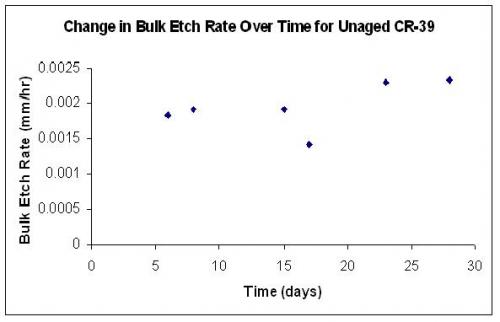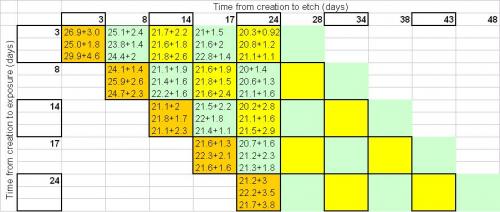The Sensitivity of Unaged CR-39
Nathan Lauffenburger
The sensitivity of CR-39 plastics depends on many environmental factors such as temperature history and humidity. Others report that CO2 is outcast from the plastic in the aging period. Also, the CR-39 changes in sensitivity in the first 21 days that it is created. CR-39 was obtained as quickly as possible from the manufacturers, which was only three days from creation.
The thickness of one piece of room temperature stored CR-39 was measured everyday. The thickness remained constant at 1.069+ .001 mm.
Every five days, one piece of unprocessed CR-39 was etched. All of the CR-39 use for this experiment was stored at room temperature. Each point on the graph represents the bulk etch rate of one piece of CR-39. It seems that the bulk etch rate is increasing but there is an anomaly around the second week.

We then began exposing the CR-39 to different charged nuclear particles every five days. 18 pieces of CR-39 are exposed to alpha particles every five days and selected ones are etched every five days. The plastic is also exposed to 2.847 MeV protons, .661 MeV helium-3s and .881 MeV tritons from our duo-plasmatron every five days (except the 17th day from creation) and selected ones are etched every ten days. The plastics exposed to alpha particles are stored in three different settings: -15°C, 5.5°C, and room temperature. The CR-39 that is exposed to particles from the duoplasmatron are stored at room temperature.
This is a chart of the pit sizes for alpha particles. The trend seems to be that the hole sizes seems to depend on the time from creation to etch, not time from creation to exposure.
- The top row of every cell is plastic stored at room temperature.
- The second row of every cell is plastic stored at 5.5oC.
- The third row of every cell is plastic stored at -15oC.
- All pit diameters are measured in microns.
- Orange cells are plastics that were etched and exposed on the same day.
- Each pit diameter measurement represents the average of approximately 15 alpha pits taken from 5 photos of the CR-39.
- All + represent an uncertainty above and below the measured value.
- The plastics in the first cell of exposure and etch on day 3 were not stored in their respective temperatures before hand, since CR-39 was in transit and was received for analysis on the third day.

